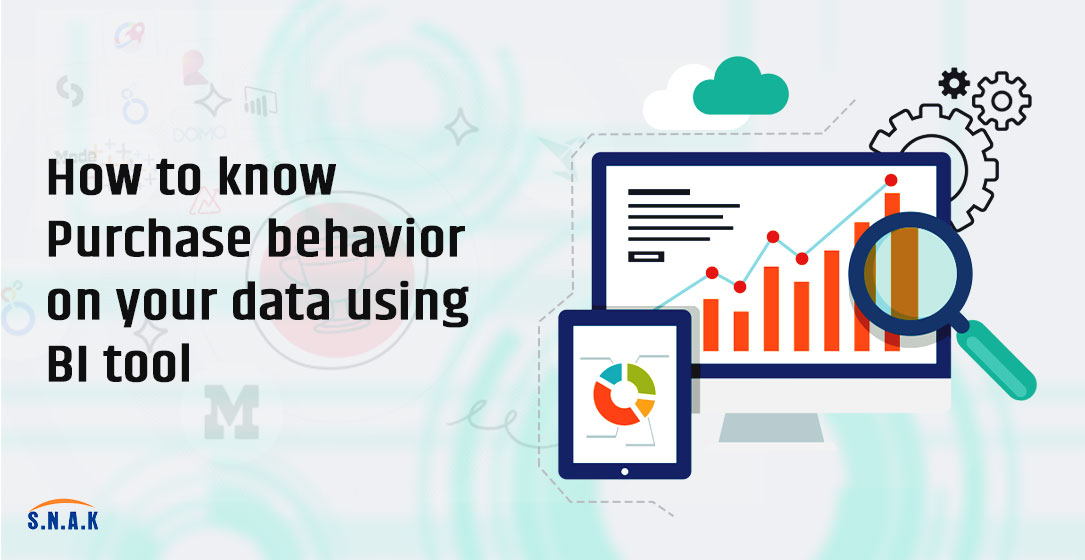February 16, 2024 | SNAK Consultancy
Share on :
How to know Purchase behavior on your data using BI tool?

In the dynamic landscape of modern business, understanding customer purchase behavior is paramount to success. Every interaction a customer has with your brand leaves a digital footprint, and leveraging this data can provide invaluable insights into their preferences, tendencies, and buying habits. Business Intelligence (BI) tools serve as powerful instruments in unraveling these insights, enabling businesses to make data-driven decisions and optimize their strategies. Let's explore how BI tools can unlock the secrets of purchase behavior within your data.
1. Data Integration and Consolidation:
The journey begins with integrating data from diverse sources such as sales transactions, customer interactions, website visits, and marketing campaigns. BI tools excel in this aspect by consolidating disparate data sets into a unified repository, eliminating silos, and providing a holistic view of customer interactions. This consolidated data serves as the foundation for analyzing purchase behavior across various touchpoints.
2. Customer Segmentation:
Once the data is aggregated, BI tool empower businesses to segment their customer base based on a myriad of factors including demographics, purchase history, geographic location, and behavioral patterns. By categorizing customers into distinct segments, organizations can tailor their marketing strategies and offerings to cater to the unique needs and preferences of each segment. This targeted approach enhances engagement and drives conversions.
3. Advanced Analytics and Visualization:
BI tool offer many analytical capabilities, enabling businesses to derive actionable insights from their data. Through interactive dashboards, visualizations, and predictive analytics, organizations can uncover purchase trends, identify patterns, and forecast future behavior. Whether it's analyzing seasonal fluctuations, identifying cross-selling opportunities, or predicting churn, BI tools provide the tools needed to extract meaningful insights.
4. Campaign Performance Evaluation:
Evaluating the effectiveness of marketing campaigns is crucial in understanding their impact on customer behavior. BI tools enable businesses to track key performance indicators (KPIs) such as conversion rates, customer acquisition costs, and campaign ROI. By correlating marketing efforts with purchase behavior, organizations can refine their strategies, optimize spending, and maximize returns on investment.
5. Customer Journey Mapping:
Mapping the customer journey is essential in understanding the various touchpoints and interactions that influence purchase decisions. BI tools facilitate the visualization of the entire customer journey, from initial awareness to post-purchase engagement. By analyzing customer interactions at each stage, businesses can identify bottlenecks, optimize conversion paths, and enhance the overall customer experience.
6. Continuous Monitoring and Adaptation:
Purchase behavior is constantly evolving, necessitating continuous monitoring and adaptation of strategies. BI tools enable real-time monitoring of key metrics, alerting businesses to changes and trends as they occur. This agile approach allows organizations to stay ahead of the curve, respond promptly to market shifts, and maintain a competitive edge in today's fast-paced environment.
In essence, BI tool serve as indispensable assets in unraveling the intricacies of customer purchase behavior. By harnessing the power of data integration, segmentation, advanced analytics, campaign evaluation, customer journey mapping, and continuous monitoring, businesses can gain invaluable insights into their customers' preferences and tendencies. With these insights, organizations can make informed decisions, optimize their strategies, and ultimately drive market growth and success.
Questionnaire
Q1: How do BI tools aid in understanding customer purchase behavior?
A1: BI tools integrate data, segment customers, visualize trends, evaluate campaigns, and monitor behavior for actionable insights.
Q2: What role does data integration play?
A2: Data integration consolidates diverse sources into a unified repository, providing a holistic view of customer interactions.
Q3: Why is customer segmentation crucial?
A3: Segmentation categorizes customers based on demographics, behavior, and preferences for targeted marketing strategies.
Q4: What insights can BI tools provide?
A4: BI tools offer analytics, visualization, and forecasting to uncover trends, predict behavior, and optimize strategies.
Q5: How do BI tools contribute to campaign evaluation?
A5: BI tools track KPIs, analyze campaign performance, and correlate efforts with purchase behavior for enhanced ROI.
Conclusion :
This blog delves into the significance of leveraging BI tools to understand customer purchase behavior, covering essential aspects such as data integration, segmentation, advanced analytics, campaign evaluation, customer journey mapping, and continuous monitoring. It underscores the transformative impact of data-driven insights on business strategies and outcomes.